PREAH KO
(879)
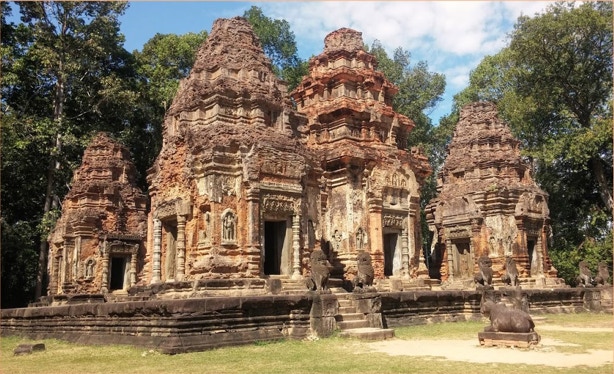
PREAH KO
(879)

PREAH KO (879)
Preah Ko, usually counted as the earliest extant temple of the Angkorian era (802-1431), is located at the site of its first capital, Hariharalaya, near the present-day village of Roluos about 15km southeast of Siem Reap and Angkor Wat. It was built as the "ancestor temple" of Indravarman I (877-889), the third Khmer king, as one of the traditional obligations of a monarch, along with erecting a state "temple mountain" and a reservoir or baray to support the surrounding capital.
The central of these three towers, slightly set-back from the rest, was dedicated to Paramesvara or "Supreme Lord," an epithet of Shiva and the posthumous name of the Empire's founder, Jayavarman II (r. 795-830.) The tower to its north (on the right) was consecrated to Rudresvara, the posthumous name of Indravarman I's maternal grandfather, the Vedic god Rudra, "Lord of Storms, equivalent to Zeus and Jupiter; his name may derive from the PIE root "to roar," cognate with "rude" and his attributes were gradually assimilated by Shiva. Khmer succession was often complicated by regarding the male relatives of a king's mother as having a claim to the throne, especially if the king's son was a minor or regarded as deficient in some respect. The southern tower (on the left) was dedicated to Prithivindrasvara, an epithet of Prithi or Prithvi, the "vast one," the great mother of the Vedic pantheon and protectress of Indravarman's father, Jayavarman III (835-877).
The three small shrines to their west (behind) are dedicated to the posthumous forms of the respective consorts (first queens) of these three men. Three "Nandi" shrines, honoring the "vehicle" of Shiva (one visible at the lower right), were placed before the steps to the temple's plinth. A dedicatory inscription links the temple to the continuity of the little-understood devaraja (god-king) cult passed down between Khmer monarchs.
Preah Khan's site plan shows its original two enclosures with a large 2nd east cruciform gopura or entrance gateway; today only the foundations of these structures remain. Evidence has been found within the 2nd enclosure of narrow buildings of unknown function which reappear as features of most later Khmer temples, until their consolidation into continuous galleries at Ta Keo (c.1000.) Two rectangular, west-facing shrines flanking the east-west or "liturgical axis,” also seem to prefigure "libraries," another mandatory structure whose actual purpose remains obscure. In the 2nd enclosure, a "cruciform walkway" linking these "libraries" to the east-west axis can be seen; one is present in nascent form at Ak Yom but appears as a discrete feature on the 1st terrace of the Baphuon and 2nd terrace of Angkor Wat.
The temple's ground plan is a notably less ambitious version of the 240 shrines at the Hindu temple at Prambanam in Java (c.859.) There, the row of three primary shrines are dedicated to the Trimurti and the matching secondary shrines to their respective vehicles – Nandi, Garuda, and the hamsa or goose of Brahma. These are surrounded by 224 parvara or small, guardian temples. The placing of a line of three shrines on a single platform or plinth is a characteristic of many early Khmer temples including Phnom Krom, Phnom Bok, and Praset Bei (all 889-915), as well as Bat Chum and Banteay Srei (c.868.)
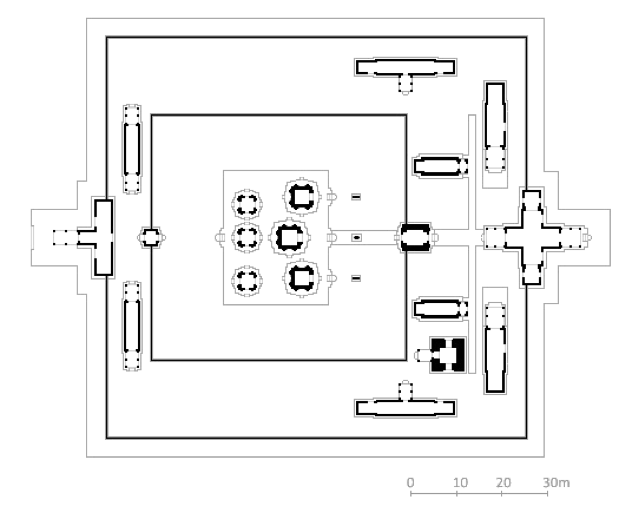
SITE PLAN, PREAH KO (879)
PREAH KO STYLE
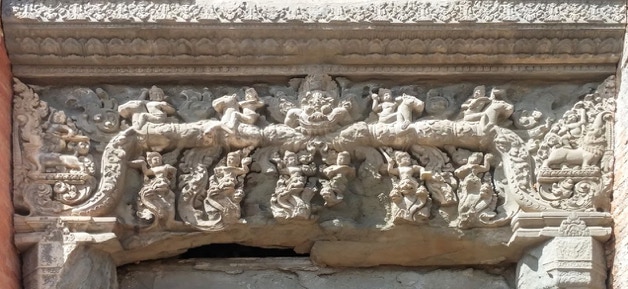
LINTEL, EAST PORTAL, SOUTHERN SHRINE, PREAH KO (879)
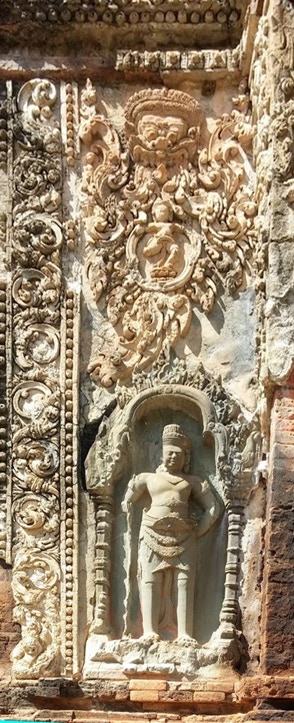
Lintels in the Preah Ko style are regarded as among the finest examples of Khmer carving. This example from the southern shrine of the front row illustrates their standard features: 1) a garland issuing from 2) the jaw of a kala, a monster, demon, kirtimukha or "face of glory." This apotropaic figure derives from the myth of a ravenous lion whom Shiva condemned to eat his own body, until, having consumed his lower jaw, he could not consume the upper or his face. 3) A god sits on the bridge of the kala's nose but is not Prithi, the goddess to whom the shrine was dedicated and who is rarely portrayed on lintels. It might represent Shiva, who was responsible for the kala's disfigurement, or Vishnu, since his right hand seems to hold a club or scepter and two lotus blossoms rise behind his throne, both iconographic symbols of that deity. 4) Four gods, devas, or heroes, some wielding ph'kaks, a Khmer weapon with two blades shaped like a hockey stick, ride horses across the garland 5) from which swags of foliage dangle, turning into 6) three-headed nagas ridden by 7) six more figures (on the left) with bows, associated with either Arjuna or Shiva, and (on the right) with clubs, one of Vishnu's attributes. The garland ends 8) with inward scrolls on which 9) gajasimhas, mythical hybrids or leogryphs with the body of a lion and head of an elephant, perch on plinths with lily-pod friezes, in place of the more usual makers or sea monsters. 10) Floral moldings crown the lintel, while 11) incised octagonal colonettes support it.
Most Angkorian temples were covered with large amounts of stucco decoration, believed to have been colored like Greek sculpture. Some of this remains in remarkably good condition, including this male dvrarapala or door guardian (at left) flanking the entrance to the southern shrine whose lintel was described in the previous paragraph. Female dvarapalas are found beside the portals of the rear row of three queens' shrines. They occupy niches which are also aedicules, that is, smaller versions of the portals which they guard, with octagonal colonettes and a torana or cusped, tri-lobed pedimental arch around them with a characteristic border of flowers also suggesting flames. The deeply-carved floral scroll work in the pilasters framing the niche is reminiscent of the garland of the lintel in the photo above, as is the ghoulish kala above the niche, drooling more vines and leaves which form a cartouche around a dancing deva.
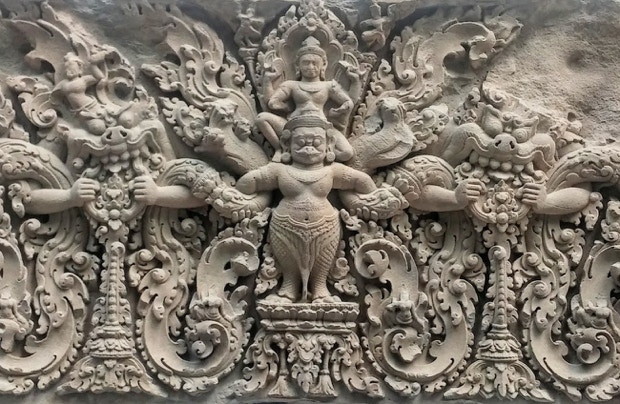
DVARAPALA, NORTH FRONT SHRINE,
PREAH KO (879)
LINTEL, PREAH KO, MUSEE GUIMET (879)
This detail of a lintel from Preah Ko, now housed at the Musée Guimet in Paris, shows Vishnu on his vehicle the half-bird, half-man Garuda, whose arms hold a deeply-carved garland. The god's remaining right hand (of an original two) brandishes one of his attributes, the chakra, a war discus, as well as the "wheel of dharma," while in his left, he holds a mace, club or scepter (his other attributes include a conch and lotus bud.) Beside Garuda, two leering kalas or kirtimukhas, vomit floral pendants, which, in the absence of their lower jaws and body, they must hold with hands growing directly from their heads, while small devatas or apsaras, celestial nymphs, dance above Vishnu's throne or mandorla. Not only is the lintel deeply incised and perfectly symmetrical, even the curves of its foliage have a constant angular momentum and rhythm across the entire composition.
40